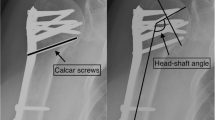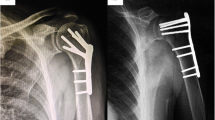Abstract
Purpose
The purpose of this study was to evaluate the clinical benefit of medial support screws for locking plating of proximal humerus fractures.
Methods
Seventy-two consecutive patients underwent prospective treatment for proximal humerus fractures with locking plates between October 2007 and September 2008. Sixty-eight patients accomplished a mean 30.8-month follow-up and were randomized into two groups: 39 patients were treated with only a locking plate and were classified in the –MSS (medial support screw) group, and 29 patients were included in the + MSS group, which were fixed with additional medial support screws. Clinical and radiological investigations were performed in both groups.
Results
The fractures united at an average of 13.6 weeks after final surgery. Comparably better shoulder function recovery was achieved in the +MSS group with regard to the Constant shoulder score (P = 0.01), with the respective excellent and good rates of 79% and 62%. Eleven patients developed various complications. A statistical difference (P = 0.036) was observed regarding the failure rate (23.1% in the −MSS group vs. 3.4% in the +MSS group). The early loss of fixation was related to higher age (P < 0.001) and less initial neck-shaft angle (NSA) (P = 0.011) of the patients. However, bone mineral density was not significantly associated with loss of fixation (P = 0.076). Although no difference was found in all types of the fractures between the +MSS and −MSS groups regarding immediate postoperative NSA, we observed a significantly lower final NSA in the −MSS group and greater secondary angle loss in the subgroup of Neer three-part (P = 0.033 and 0.015, respectively) and four-part fractures (P = 0.043 and 0.027).
Conclusions
Anatomical reduction can substantially decrease the risk of postoperative failure in locking plating of proximal humerus fractures. Medial support for proximal humerus fractures seems to have no benefits in Neer two-part fractures. However, the additional medial support screws inserted into the medio-inferior region of the humeral head may help to enhance mechanical stability in complex fractures and allow for better maintenance of reduction.

Similar content being viewed by others
References
Agudelo J, Schurmann M, Stahel P, Helwig P, Morgan SJ, Zechel W, Bahrs C, Parekh A, Ziran B, Williams A, Smith W (2007) Analysis of efficacy and failure in proximal humerus fractures treated with locking plates. J Orthop Trauma 21(10):676–681. doi:10.1097/BOT.0b013e31815bb09d
Volgas DA, Stannard JP, Alonso JE (2004) Nonunions of the humerus. Clin Orthop Relat Res 419:46–50. doi:00003086-200402000-00008
Iannotti JP, Ramsey ML, Williams GR, Warner JJP (2003) Nonprosthetic management of proximal humeral fractures. J Bone Joint Surg Am 85(8):1578–1593
Gardner MJ, Griffith MH, Demetrakopoulos D, Brophy RH, Grose A, Helfet DL, Lorich DG (2006) Hybrid locked plating of osteoporotic fractures of the humerus. J Bone Joint Surg Am 88(9):1962–1967. doi:10.2106/JBJS.E.00893
Roderer G, Gebhard F, Krischak G, Wilke HJ, Claes L (2010) Biomechanical in vitro assessment of fixed angle plating using a new concept of locking for the treatment of osteoporotic proximal humerus fractures. Int Orthop. doi:10.1007/s00264-010-1021-9
Gardner MJ, Weil Y, Barker JU, Kelly BT, Helfet DL, Lorich DG (2007) The importance of medial support in locked plating of proximal humerus fractures. J Orthop Trauma 21(3):185–191. doi:10.1097/BOT.0b013e3180333094
Lescheid J, Zdero R, Shah S, Kuzyk PR, Schemitsch EH (2010) The biomechanics of locked plating for repairing proximal humerus fractures with or without medial cortical support. J Trauma 69(5):1235–1242. doi:10.1097/TA.0b013e3181beed96
Neer CS 2nd (1970) Displaced proximal humeral fractures. I. Classification and evaluation. J Bone Joint Surg Am 52(6):1077–1089
Constant CR, Murley AH (1987) A clinical method of functional assessment of the shoulder. Clin Orthop Relat Res 214:160–164
Fjalestad T, Stromsoe K, Blucher J, Tennoe B (2005) Fractures in the proximal humerus: functional outcome and evaluation of 70 patients treated in hospital. Arch Orthop Trauma Surg 125(5):310–316. doi:10.1007/s00402-005-0803-9
Olsson C, Nordquist A, Petersson CJ (2005) Long-term outcome of a proximal humerus fracture predicted after 1 year: a 13-year prospective population-based follow-up study of 47 patients. Acta Orthop 76(3):397–402
Shahid R, Mushtaq A, Northover J, Maqsood M (2008) Outcome of proximal humerus fractures treated by PHILOS plate internal fixation. Experience of a district general hospital. Acta Orthop Belg 74(5):602–608
Siffri PC, Peindl RD, Coley ER, Norton J, Connor PM, Kellam JF (2006) Biomechanical analysis of blade plate versus locking plate fixation for a proximal humerus fracture: comparison using cadaveric and synthetic humeri. J Orthop Trauma 20(8):547–554. doi:10.1097/01.bot.0000244997.52751.58
Micic ID, Kim KC, Shin DJ, Shin SJ, Kim PT, Park IH, Jeon IH (2009) Analysis of early failure of the locking compression plate in osteoporotic proximal humerus fractures. J Orthop Sci 14(5):596–601. doi:10.1007/s00776-009-1382-3
Solberg BD, Moon CN, Franco DP, Paiement GD (2009) Locked plating of 3- and 4-part proximal humerus fractures in older patients: the effect of initial fracture pattern on outcome. J Orthop Trauma 23(2):113–119. doi:10.1097/BOT.0b013e31819344bf
Friess DM, Attia A (2008) Locking plate fixation for proximal humerus fractures: a comparison with other fixation techniques. Orthopedics 31(12)
Lill H, Hepp P, Korner J, Kassi JP, Verheyden AP, Josten C, Duda GN (2003) Proximal humeral fractures: how stiff should an implant be? A comparative mechanical study with new implants in human specimens. Arch Orthop Trauma Surg 123(2–3):74–81. doi:10.1007/s00402-002-0465-9
Owsley KC, Gorczyca JT (2008) Fracture displacement and screw cutout after open reduction and locked plate fixation of proximal humeral fractures [corrected]. J Bone Joint Surg Am 90(2):233–240. doi:10.2106/JBJS.F.01351
Tingart MJ, Lehtinen J, Zurakowski D, Warner JJ, Apreleva M (2006) Proximal humeral fractures: regional differences in bone mineral density of the humeral head affect the fixation strength of cancellous screws. J Shoulder Elbow Surg 15(5):620–624. doi:10.1016/j.jse.2005.09.007
Clavert P, Zerah M, Krier J, Mille P, Kempf JF, Kahn JL (2006) Finite element analysis of the strain distribution in the humeral head tubercles during abduction: comparison of young and osteoporotic bone. Surg Radiol Anat 28(6):581–587. doi:10.1007/s00276-006-0140-x
Hepp P, Lill H, Bail H, Korner J, Niederhagen M, Haas NP, Josten C, Duda GN (2003) Where should implants be anchored in the humeral head? Clin Orthop Relat Res 415:139–147. doi:10.1097/01.blo.0000092968.12414.a8
Liew AS, Johnson JA, Patterson SD, King GJ, Chess DG (2000) Effect of screw placement on fixation in the humeral head. J Shoulder Elbow Surg 9(5):423–426. doi:10.1067/mse.2000.107089
Conflict of interest
The authors declare that they have no conflict of interest.
Author information
Authors and Affiliations
Corresponding author
Additional information
There was no financial support for this project. The authors have received nothing of value. The medical devices used in this study were approved by the Wenzhou Medical College Institutional Review Board (study number: 2006-1365).
Rights and permissions
About this article
Cite this article
Zhang, L., Zheng, J., Wang, W. et al. The clinical benefit of medial support screws in locking plating of proximal humerus fractures: a prospective randomized study. International Orthopaedics (SICOT) 35, 1655–1661 (2011). https://doi.org/10.1007/s00264-011-1227-5
Received:
Accepted:
Published:
Issue Date:
DOI: https://doi.org/10.1007/s00264-011-1227-5




